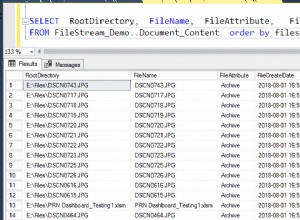Jak napisano w powyższym komentarzu, powinieneś dzielić i zwyciężać, aby ułatwić sobie życie (szczególnie, gdy piszesz kod, bawiąc się nim w tej dużej funkcji). To działa tak łatwo, jak:
function file_put($number, $data)
{
$path = sprintf("C:/temp/wamp/www/file%d.txt", $number);
file_put_contents($path, $data);
}
na przykład jest to po prostu zastąpienie wielu zduplikowanych wierszy, w których potrzebujesz tylko (ponumerowanego) pliku, w którym umieściłeś jakiś ciąg.
Ale możesz to zrobić także z bardziej złożonymi rzeczami, takimi jak operacje na bazie danych. Prawdopodobnie chcesz usunąć obsługę błędów poza zasięg wzroku, a także zadbać o łączenie się z bazą danych w razie potrzeby i bardziej elastyczny sposób pobierania danych. Można to zrobić, przesuwając (delikatnie przestarzały) mysql_* funkcjonuje w jednej lub dwóch własnych klasach, tak że znika z oczu. To znacznie ułatwi korzystanie z niego (co pokazuję najpierw):
// Create your database object to use it later on:
$config = array(
'server' => 'localhost',
'name' => 'root',
'password' => '',
'db' => 'test',
);
$db = new MySql($config);
Nazwałem klasę bazy danych MySql ponieważ reprezentuje połączenie mysql i działa ze starym rozszerzeniem mysql. Musisz tylko przekazać ten obiekt bazy danych do funkcji w swoim pytaniu. W połączeniu z file_put funkcji, wyglądałoby to tak:
function checkin(MySql $DB, $TechID, $ClientID, $SiteID)
{
$query = sprintf("SELECT `Type` FROM `Log` WHERE `TechID` = '%d' ORDER BY LogTime DESC LIMIT 1", $TechID);
file_put(5, $query);
$result1 = $DB->query("SELECT COUNT(*) FROM Log");
$result2 = $DB->query($query);
foreach ($result1 as $row1) {
list($count) = $row1;
$data = "ClientID:$ClientID TechID:$TechID SiteID:$SiteID Count:$count"
file_put(3, $data);
foreach ($result2 as $row2) {
file_put(4, $data);
}
}
}
Nadal checkin Funkcja jest prawie duża (już 12 wierszy kodu), ale jest znacznie krótsza niż twoja pierwsza wersja, ponieważ deleguje pracę do zapisywania plików i uzyskiwania dostępu do bazy danych. Mam nadzieję, że ta demonstracja się przyda. Poniżej znajduje się pełny przykład kodu:
/**
* MySql Exception
*/
class MySqlException extends RuntimeException
{
}
/**
* MySql Database Class
*/
class MySql
{
private $server;
private $name;
private $password;
private $db;
private $connection;
public function __construct(array $config)
{
$this->server = $config['server'];
$this->name = $config['name'];
$this->password = $config['password'];
$this->db = $config['db'];
}
private function connect($server, $name, $password)
{
$this->connection = mysql_connect($server, $name, $password);
if (!$this->connection) {
$this->error("Unable to connect to '%s' as user '%s'", $server, $name);
}
}
private function select($db)
{
if (!mysql_select_db($db, $this->connection)) {
$this->error("Unable to select database '%s'", $db);
}
}
private function close()
{
$this->connection && mysql_close($this->connection);
}
private function connectSelect()
{
$this->connect($this->server, $this->name, $this->password);
$this->select($this->db);
}
/**
* @param $query
* @return MySqlResult
*/
public function query($query)
{
$this->connection || $this->connectSelect();
$result = mysql_query($query, $this->connection);
if (!$result) {
$this->error("Unable to execute query '%s'", $query);
}
return new MySqlResult($result);
}
/**
* @param string $format
* @param ...
* @throws MySqlException
*/
private function error($format)
{
$args = func_get_args();
array_shift($args);
$format .= ': %s';
$args[] = $this->connection ? mysql_error($this->connection) : mysql_error();
throw new MySqlException(vsprintf($format, $args));
}
public function __destruct()
{
$this->close();
}
}
/**
* MySql Result Set - Array Based
*/
class MySqlResult implements Iterator, Countable
{
private $result;
private $index = 0;
private $current;
public function __construct($result)
{
$this->result = $result;
}
public function fetch($result_type = MYSQL_BOTH)
{
$this->current = mysql_fetch_array($this->result, $result_type);
return $this->current;
}
/**
* Return the current element
* @link http://php.net/manual/en/iterator.current.php
* @return array
*/
public function current()
{
return $this->current;
}
public function next()
{
$this->current && $this->fetch();
}
/**
* Return the key of the current element
* @link http://php.net/manual/en/iterator.key.php
* @return mixed scalar on success, or null on failure.
*/
public function key()
{
return $this->current ? $this->index : null;
}
/**
* Checks if current position is valid
* @link http://php.net/manual/en/iterator.valid.php
* @return boolean The return value will be casted to boolean and then evaluated.
* Returns true on success or false on failure.
*/
public function valid()
{
return (bool)$this->current;
}
/**
* Rewind the Iterator to the first element
* @link http://php.net/manual/en/iterator.rewind.php
* @return void Any returned value is ignored.
*/
public function rewind()
{
$this->fetch();
}
/**
* Count of rows.
*
* @link http://php.net/manual/en/countable.count.php
* @return int The count of rows as an integer.
*/
public function count()
{
return mysql_num_rows($this->result);
}
}
// Create your database object to use it later on:
$config = array(
'server' => 'localhost',
'name' => 'root',
'password' => '',
'db' => 'test',
);
$db = new MySql($config);
function file_put($number, $data)
{
$path = sprintf("C:/temp/wamp/www/file%d.txt", $number);
file_put_contents($path, $data);
}
function checkin(MySql $DB, $TechID, $ClientID, $SiteID)
{
$query = sprintf("SELECT `Type` FROM `Log` WHERE `TechID` = '%d' ORDER BY LogTime DESC LIMIT 1", $TechID);
file_put(5, $query);
$result1 = $DB->query("SELECT COUNT(*) FROM Log");
$result2 = $DB->query($query);
foreach ($result1 as $row1) {
list($count) = $row1;
$data = "ClientID:$ClientID TechID:$TechID SiteID:$SiteID Count:$count";
file_put(3, $data);
foreach ($result2 as $row2) {
file_put(4, $data);
}
}
}
checkin($db, 1, 2, 3, 4);




